Mies van der Rohe and the Universal Space Project
I must say that I was far more riveted by another Mies . . . who, in perfect International Style manner continued to insist on architecture and the production of truth as generated by a set of a priori and universalizing laws, and who was caught up in the entirely modernist obsession of repeating a very small repertory of structural ideas — namely the prismatic tower and the universal space of the clear-span pavilion — and was, throughout his career, committed to the use of the grid.
– Rosalind Krauss
Mies loved perhaps long-span buildings better than tall buildings.
– Gene Summers
Mies van der Rohe’s exploration of universal space and the potentials of clear-span construction began during the war years through his teaching at the Armour Institute in Chicago (now the Illinois Institute of Technology), where he served as director of the Department of Architecture after leaving Germany in 1938. The early projects of note were collaborations with his students – the first being the Concert Hall Project, a theoretical space for 3,000 people that Mies initiated in 1941 with his student, Paul Campagna. Ultimately, Mies took over the work and his office went on to produce the famous collage of Albert Kahn’s Glenn L Martin Aircraft Assembly Building by converting the wartime structure into a large concert hall using only a series of floating acoustical planes in an otherwise uninterrupted space. The work marked a significant conceptual break for Mies as he began to reconcile the continuous horizontal plane with ideas of a large single-span shed and its ensuing flexibility.
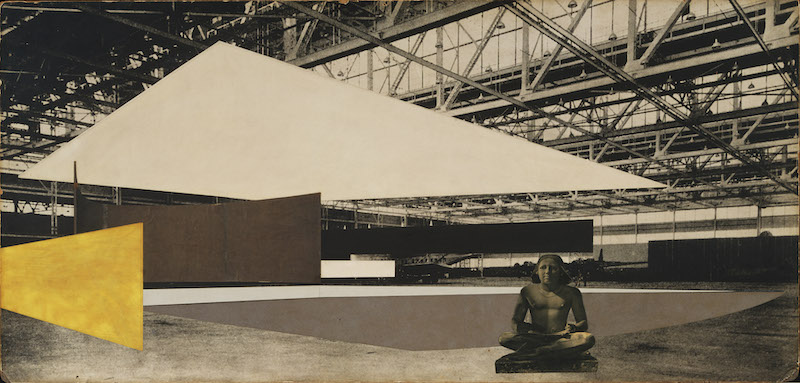
Directly following the Concert Hall Project, Mies developed another important theoretical proposal – a Museum for a Small City – in response to a prompt from the magazine Architectural Forum. This time he was working with another student, George Danforth. While the Concert Hall is fundamentally a conceptual exercise using an appropriated framework (Kahn’s Aircraft Assembly Building), the Museum for a Small City represents a first attempt at his own specific architectural solution. The museum utilised a regular column grid and so the project itself was not, strictly speaking, a clear-span structure. There is, however, a small but special moment in the plan where four columns were omitted, in turn allowing for an uninterrupted auditorium space within the columnar field. To achieve this, Mies spanned over the seating area with two upset girders, from which the roof hangs.
The perspective sketch that he selected for publication in 1943 interestingly shows these girders peeking out, heroically almost, above the roof line. It was an exoskeleton meant to be seen and a direct precursor to the more dramatic Cantor Drive-In Restaurant – an unbuilt and often overlooked project that Mies developed for Indianapolis businessman Joseph Cantor for one of his local franchises. Here, Mies hung the roof from two massive exposed lattice trusses that span in the long and structurally more challenging direction, producing an almost Venturian-like billboard of the framework. The result was an especially strong image in the context of the emerging postwar American landscape, particularly from the vantage of the automobile. And although the project has largely faded from the Miesian canon over the years, likely due to its low associations, it should still be remembered that Mies proudly included the Cantor Drive-In in his retrospective exhibition at the Museum of Modern Art in 1947.
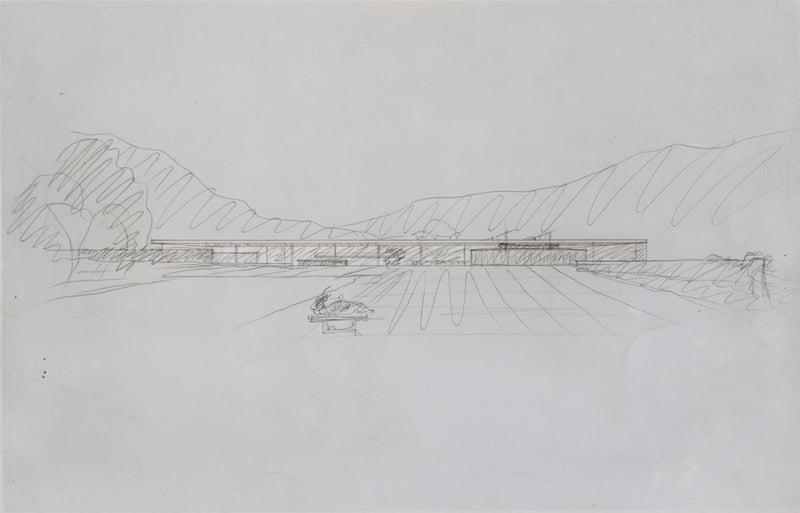
Our drawing series begins at this strange and sometimes forgotten point and describes eight of the key universal space projects that Mies developed during his years in America. Using primarily the material from the Mies van der Rohe Archive at the Museum of Modern Art, we have produced a series of new large-format drawings of these seminal projects in an effort to bring these works into a more direct dialogue and to reframe the universal space projects (plural) as a more singular, overarching pursuit. The drawing work was, in hindsight, a rather sizeable task for my small office to undertake, but we had the required time and curiosity on our side and I was fortunate to have the invaluable drafting assistance of Ki Yeol Baek and Harrison Moser in the process. Early on I was also fortunate to connect with David Dunlap of The New York Times who generously provided us with additional drawings that his late father, William Dunlap, had of the Farnsworth House from his time at Mies’ office. These included the steel shop drawings from Wendnagel and Company as well as the screen panels and doors his father designed for the porch (which were completed behind the scenes, with Mies’ blessing, after the office’s services were acrimoniously terminated in 1951). What was especially compelling to us about this material was the dissonance between the collectively understood imagery of the house and many of the technical details, which prompted the subject and graphic technique of many of our representations moving forward. Mies’ image making prowess was, up until the end, perpetually ahead of the physical constructions and the Dunlap material served as a strong reminder of that and pushed our drawing work to be exacting and impartial.
The graphic consistency of our drawings was especially important for comparative purposes because the universal space projects, in many respects, are a motley bunch. Only three were built. Of the unbuilt projects, one was without a client or even a prompt. The scales of the works and their respective programmes vary immensely, from the individual houses to the colossal 220 x 220 m column-free Convention Hall in Chicago. Regardless of their differences however, the universal space projects can most informatively be sorted into two camps: the gothic and the classical. The gothic was a term that Mies used to describe his one-way free-span structures, likening them to the flying buttresses of gothic cathedrals. Sometimes his office referred to them as sausage extrusions since the structural concept did not dictate the building’s length. These projects include: the Cantor Drive-In Restaurant in Indianapolis, Indiana (1945–48), the Farnsworth House in Plano, Illinois (1945–51), the Architecture and Institute of Design Building (SR Crown Hall at IIT) in Chicago, Illinois (1950–56), and the competition entry for the National Theatre in Mannheim, Germany (1952–53).
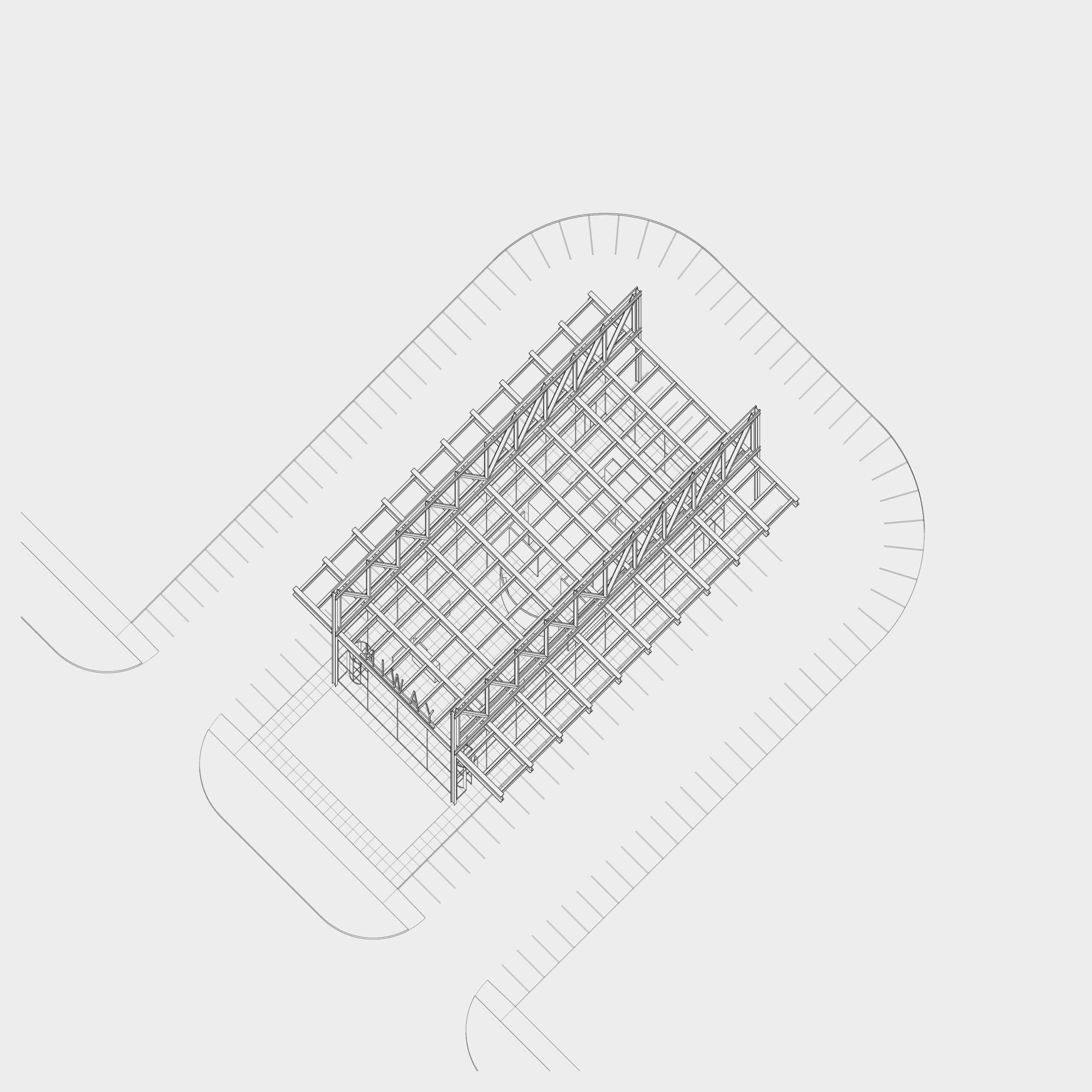
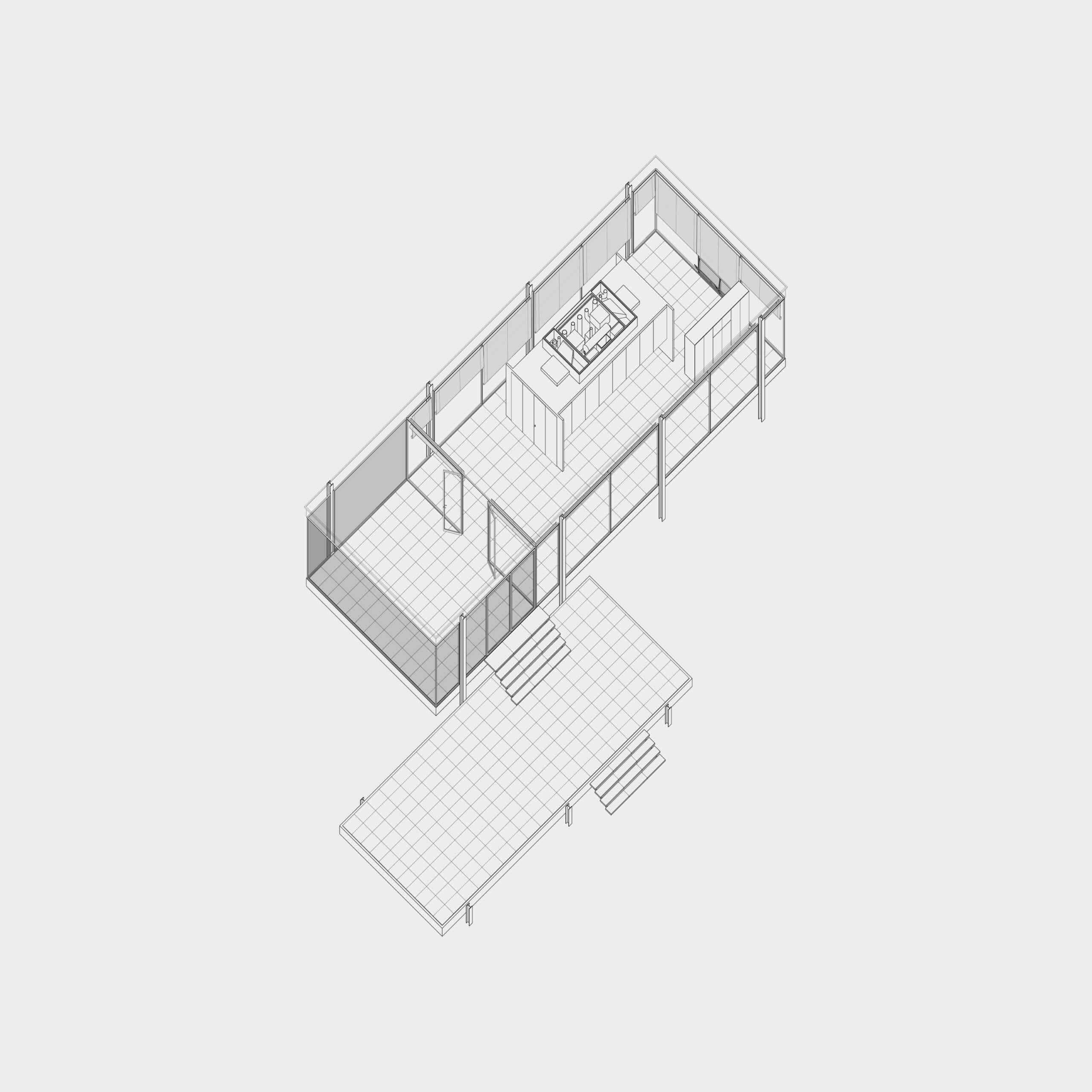


Mies used the term classical to describe his two-way structures which he likened to the peripteros of Greek architecture – a temple surrounded by a colonnade on all four sides. The classical projects include: the Convention Hall in Chicago, Illinois (1953–54), the Bacardi Administration Building in Santiago, Cuba (1957–60), and the Neue Nationalgalerie in Berlin, Germany (1962–68). Generally speaking, the earlier works fall into the gothic camp and the later works fall into the classical camp. Sandwiched between these two groups is the 50 x 50 House (1951–52), where Mies, in close collaboration with his former student and long-time assistant Myron Goldsmith, developed both one- and two-way solutions before settling on a classical structure in the final iterations – a logical outcome of the square plan.
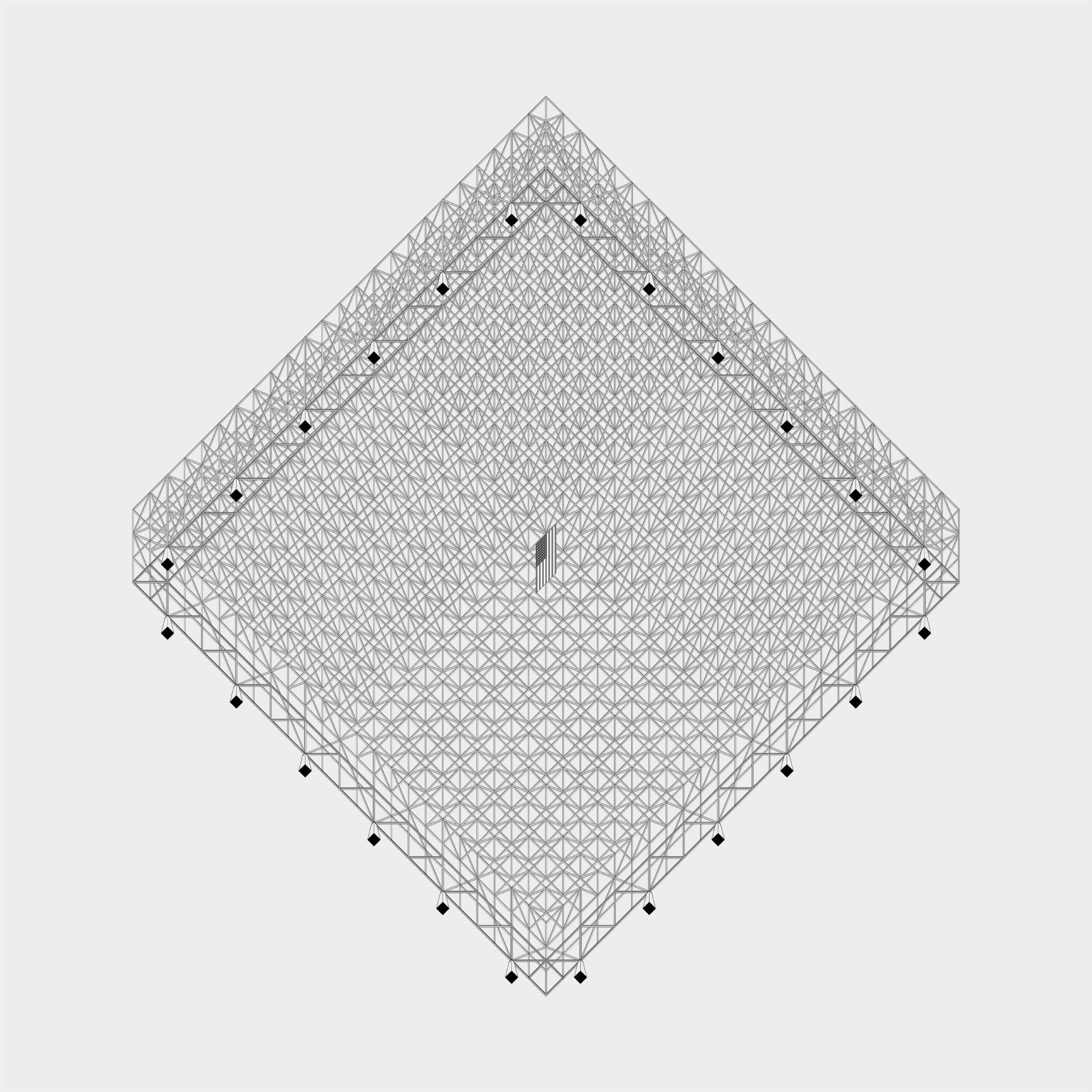
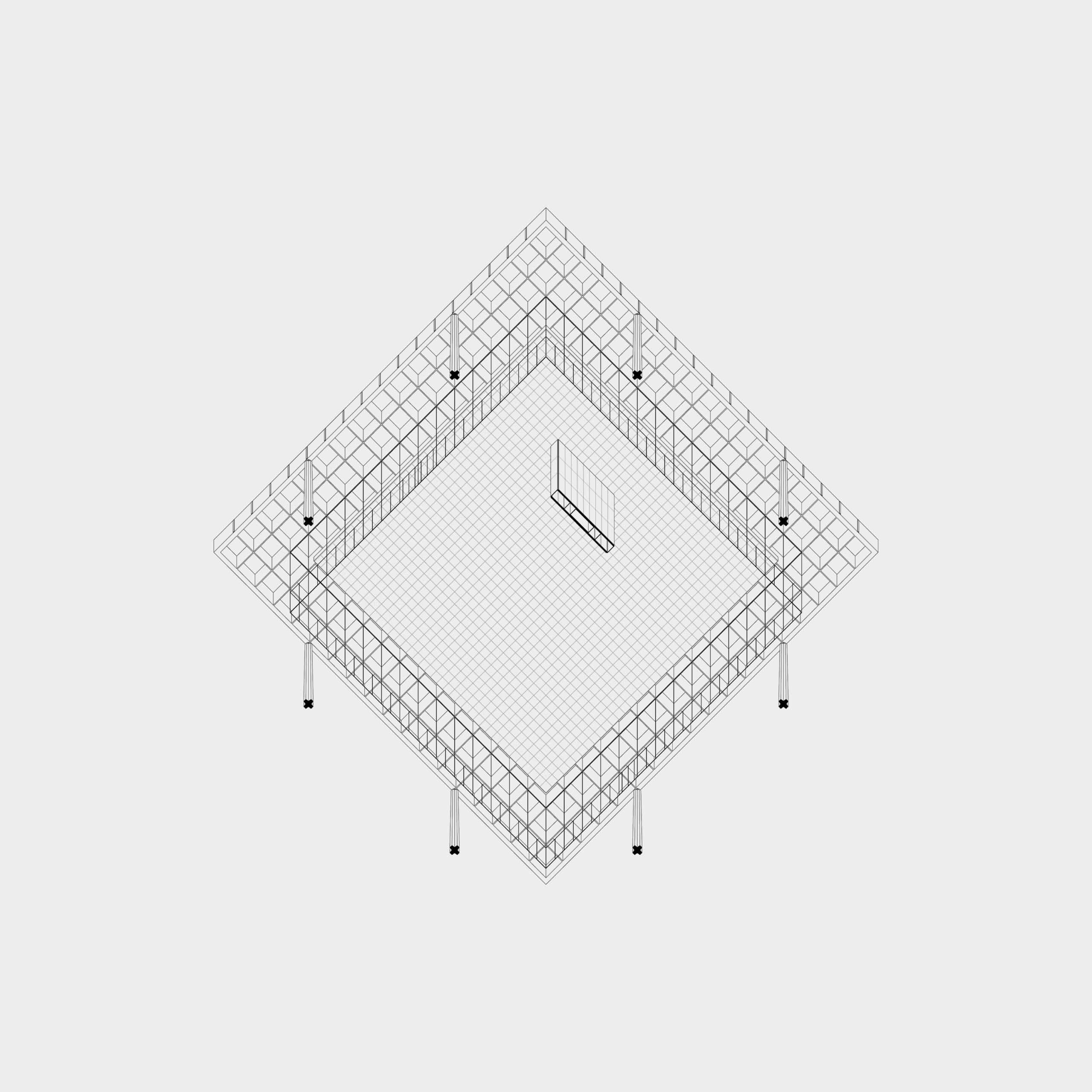
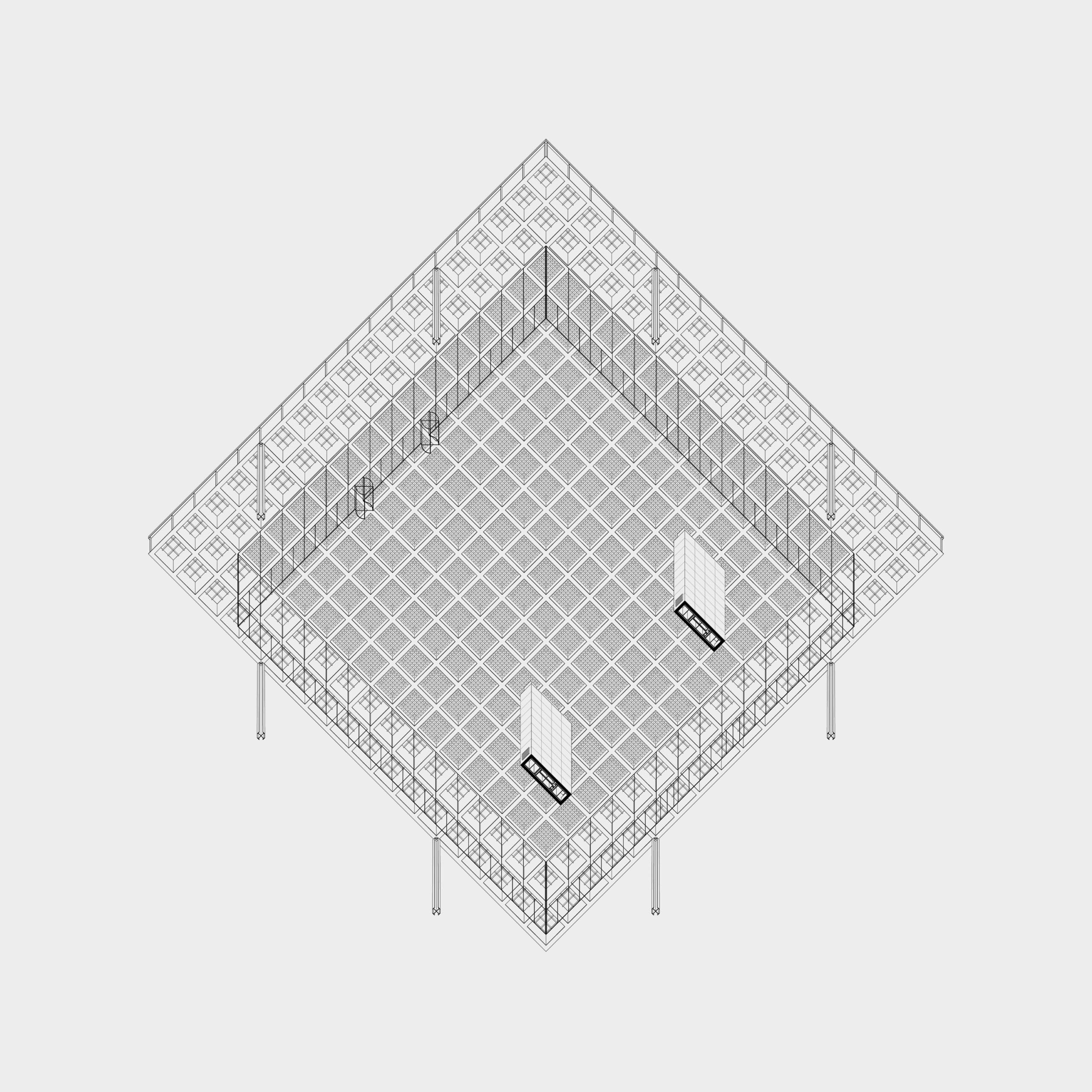
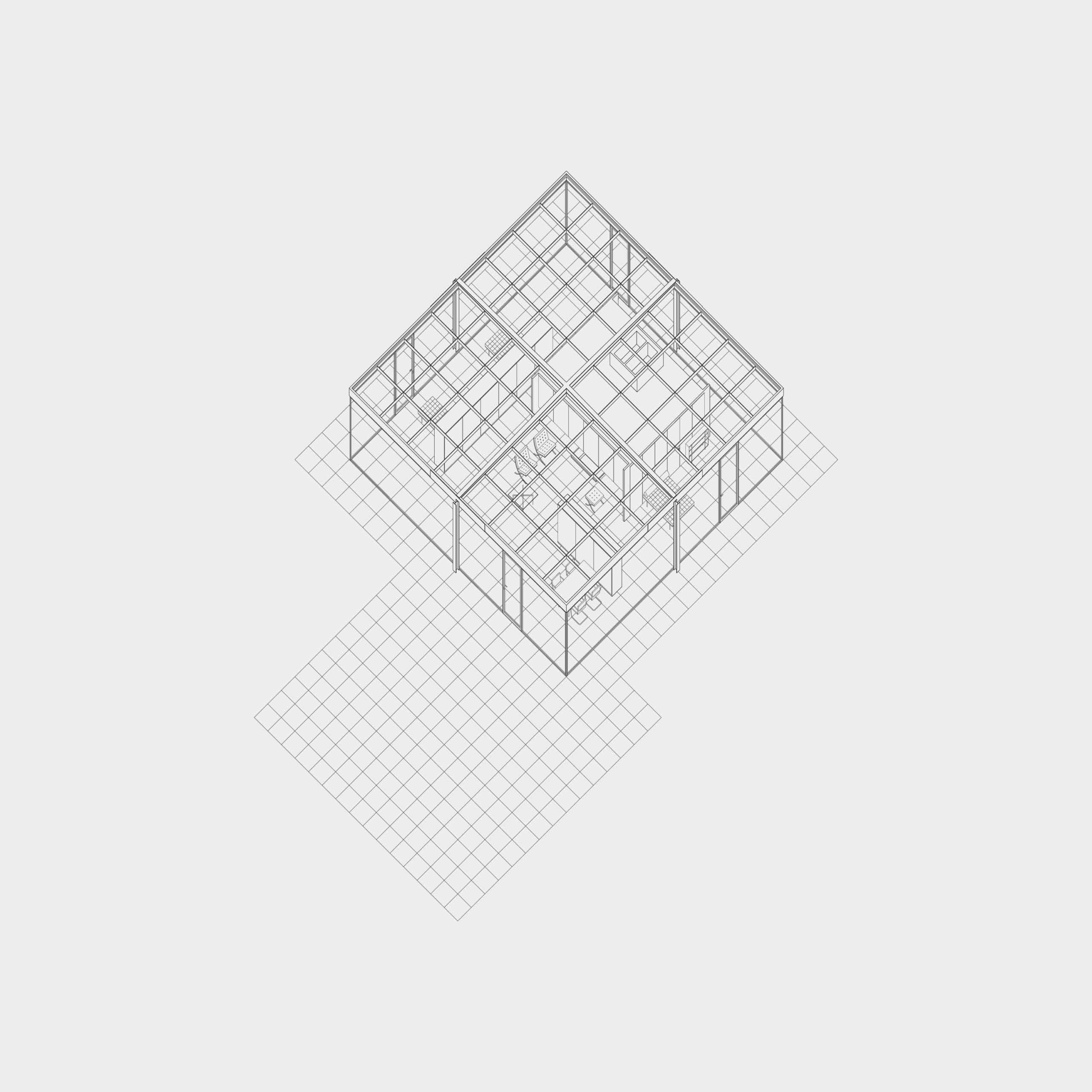
Each building in the series is drawn at least once in a 45-degree axonometric format, either regular or reverse axis depending on the subject of the drawing, and depicts the structural elements. It is a bit of a contrarian or outsider’s rendition given the rarity Mies used axonometry, but contrary to the Miesian perspective, the axonometric drawing favoured by many of his contemporaries proved especially helpful in looking past architectural effects and Miesian illusionism to the reality of the constructions themselves. Furthermore, the 45-degree axon (military projection) served to emphasise the roof or ceiling plane and to frustrate a frontal reading of the buildings, and thus became a baseline portrait of each of the works.
With a few exceptions, the gothic structures are drawn from above and emphasise the exterior structure and the classical square plan structures are drawn in reverse axis (worm’s eye) and shift the focus from the roofscape to the interior ceiling plane. In the teetering moment of the 50 x 50 House both drawing techniques are used. Elevations and sections were produced on occasion – for the Farnsworth House to illustrate the floods that have plagued the Fox River property over the years (which Mies planned for, but obviously underestimated), for Robert Silman Associates’ semi-recent proposed in-situ hydraulic solution to preserve the house, and for the Neue Nationalgalerie to illustrate the dramatic nine-hour procedure of raising the 1,000-ton roof into place in April of 1967. The numerous configurations of the 50 x 50 House are shown in plan and highlight the flexibility that Mies explored within the neutrality of a column-free space.
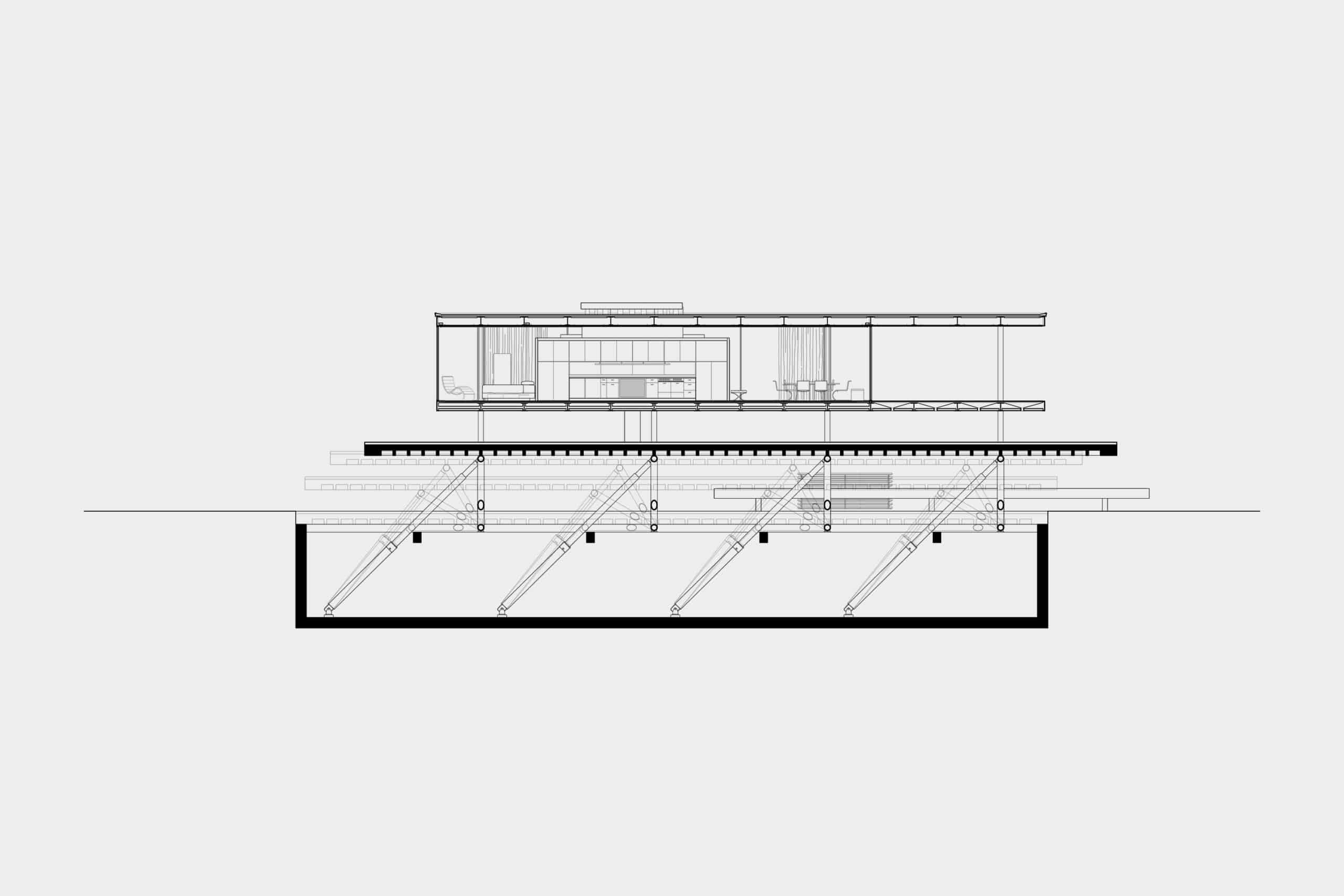
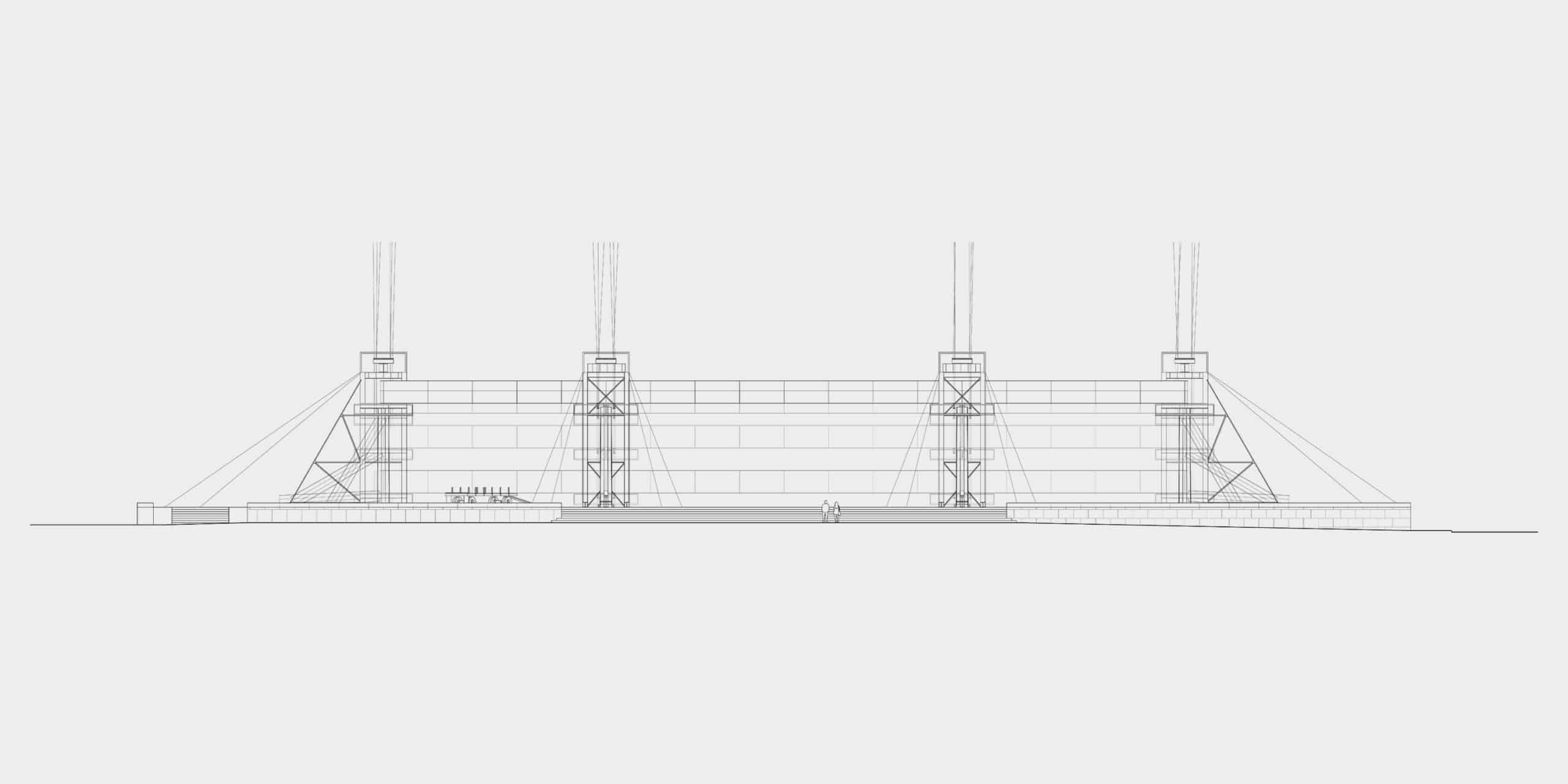
In 1969, in the last year of Mies’ office, an unusual drawing was produced that featured the major universal space projects, each drawn in elevation at 1:500. The projects were numbered 1 through 7 and were arranged from top to bottom on the sheet. The built and the unbuilt were drawn equally without distinction. The drawing was unusual, not only because of its commemorative nature, but also because the ordering of the work was more conceptual than synchronic, despite the implication of the layout. The Cantor Drive-In was excluded and the first project was the Farnsworth House. Mannheim and Crown Hall are in the number 2 and 3 spots respectively, the 50 x 50 House in position number 4, followed by the Convention Hall and so on. The subtle re-ordering of some of the work neatly places the gothic projects (numbered 1–3) before the classical projects (numbered 4–7), with the 50 x 50 House located in the middle of the sequence. The drawing then is more than simply a cleaned-up or comparative summary of individual works. Rather, in its revisionist order, it functions more as an evolutionary diagram and a documentation of Mies’ broader pursuit of universal space and its ideal language. In essence it is a drawing about a single project and, consequently, is key to understanding this body of work in its totality.

From this evolutionary vantage, Mies’ move away from the rectangular plan to the more universal form of the square takes on special significance. Furthermore, this move closely correlates with Mies’ shedding of many of his De Stijl influenced formal tendencies, the absence of which proved especially liberating in his development. The shifting compositions of the Farnsworth House’s platforms and glass enclosure and its slightly off-centre entry doors and service core are followed by increasing symmetries – the bi-lateral symmetry found in the National Theatre and in Crown Hall and the four lines of symmetry found in the square plan classical projects. As a result of this increased symmetry the classical works do not have a dominant grain, either structurally (in the traditional sense of the word) or more broadly in terms of organisation. Entrances, for instance, are only indicated via the building’s larger site and the roofs exhibit a cool independence from the forms and life below. While the earlier gothic projects establish clear points of entry and suggest the expansion of space along one axis, the classical projects are free from these constraints and grow progressively more abstract and expansive in all directions. And in the culmination of the Miesian outbound column – at Bacardi and at the Neue Nationalgalerie – the glass and primary structure are separated entirely. From the interior view, the roof is no longer bound by vertical supports slipping mysteriously past an abstract ceiling plane, in turn rendering earlier works like Crown Hall almost hermetic in their perimeter expression.
The square plan also coincided with Mies’ further development of a clear construction (to use his phrase) through the outward diagram of structure, an idea he understood in terms of both fact and appearance. While one could certainly argue that the earlier gothic projects are more expressive works, their extroversion is a highly edited one and comparatively simple construct; the primary spanning members are clearly visible on the exterior while secondary and tertiary members are concealed within the roof sandwich. As such, Mies’ skin and bones architecture is fundamentally different than the early brutalist projects such as the Smithsons’s Hunstanton School in Norfolk – projects that were inspired by Mies’ early IIT work but share little, if any, of its transcendentally focused manipulation. Moreover, as Mies’ work evolved so too did his manipulation; his works appear increasingly truthful and simple, but the tricks grow ever more refined and sophisticated. One of the areas where this is most evident is in the roof structures and their respective expressions, again underscoring the significance of the 50 x 50 House as the inflection point between the gothic and classical works. It was in the 50 x 50 House studies that Mies first shows the roof structure on the interior and shows it in its entirety. While the earliest drafted structural iteration of the house featured two overhead girders (resembling a sort of mini squared-off version of Crown Hall), the later iterations acknowledged the square plan with variations of a two-directional solution. In the final version of the house, Mies does away with any indication of hierarchy within the 8 x 8 structural grid, in both the projected roof plan and in the reflected ceiling plan. The result was a square roof comprised of 64 individual and undifferentiated square units – a finely presented coffered structure rich in the symbolism of two crossing axes, where both part and whole embrace the logic of the figure.
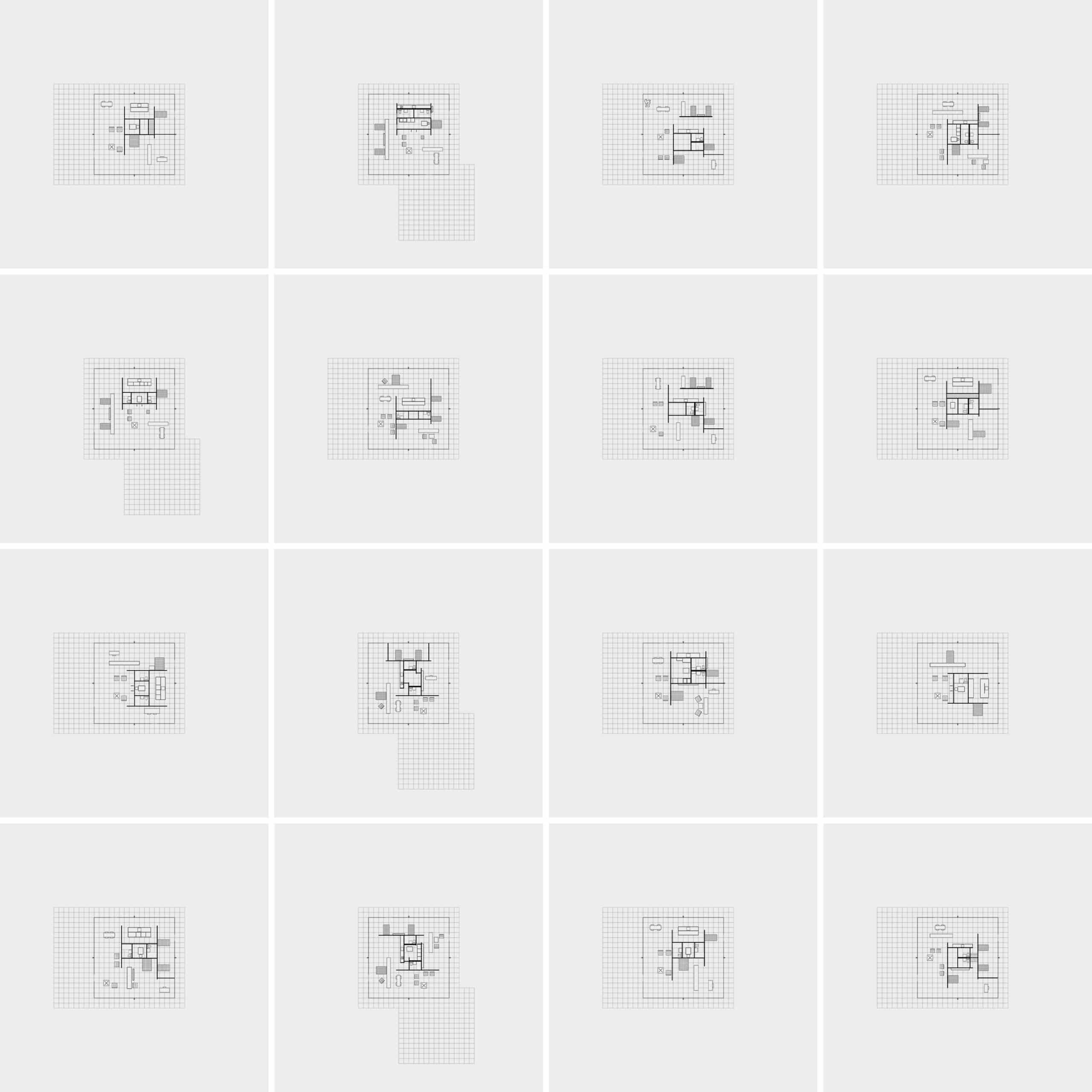
The subsequent and larger classical projects take steps both forward and backward in broadcasting what one might call a structural truth – that a work’s appearance should align with and register its structural system. In the Convention Hall for example, Mies not only reveals the roof structure, but also articulates the structure of the facades on both the exterior and interior elevations. The various infill strategies Mies explored for the project used marble, and then later, metal. These insulated panels, fitted between the steel sections, produced the same reading from the inside and from out – a significant departure from the more externally focused personalities of the gothic works. The reinforced concrete structure of the Barcardi Administration Building several years later does not share the Convention Hall’s purity of expression and concept, but the presentation of the concrete structure does take on several important new directions despite the project’s relative awkwardness within Mies’ oeuvre. First, the roof is supported directly by eight concrete cruciform piers, whose centrelines are located directly below the roof’s perimeter line. Primarily due to the building’s scale and the weight of concrete, the vertical forces are expressed here with greater clarity and directness in comparison to earlier solutions where vertical members support a suspension structure (that is, the roof being hung off columns). Second, the glazed perimeter of the building envelope was set back to provide shading – an environmentally prompted configuration that no doubt had more artistic resonance with Mies because it presented the structure itself as a distinct element. Third, Bacardi required a thickened perimeter beam as well as an increased depth to the concrete space frame towards the centre of the span, a condition Mies predictably hid with a drop ceiling inset inbound from the glass line.
Free of the corrosive issues of building in the tropical Cuban climate and with the experience of Bacardi behind him, Mies was able to resolve these issues in Berlin entirely in steel and without the crutch of an opaque ceiling plane. The structural impurities or idiosyncrasies – the unseen bolted connections or diagonal members found, for example, in the Farnsworth House or Crown Hall – are notably absent in the Neue Nationalgalerie where the structure is entirely visible and where roof loads, weld creep, and visual appearances are resolved in sophisticated fashion through cambering. Whether or not these earlier suppressed and more ordinary construction assemblies were concessions driven by budgets or wartime economies, the uninterrupted finished ceiling planes in the gothic projects nonetheless served to facilitate a purer reading of the structure and highlight the duelling interests of the visual and the tectonic in Mies’ work. As the universal space projects evolved, the seemingly conflicting nature of these interests – the representation of structure and the structure itself – are brought into increasing alignment while still retaining their integrity as distinct modes of thought and readings of his work.
The progression of the visual-tectonic relationships in Mies’ work, as well as other hidden or suppressed conditions, were of particular interest in our drawing series and the absence of finished floors and ceiling surfaces in many instances reveal the forces and flows he was contending with – structurally, thermally, or otherwise. The universal space projects, rendered in this more skeletal fashion, also underscore the degree to which Mies was able to reconcile his conservative and radical ideals – that is, tectonic form and other material concerns versus infinite space, the sublime, and the spiritual ambitions of the avant-garde. Even with limited knowledge of Mies’ work this can be intuited here; in their stripped-down state the gothic projects appear almost messy in comparison to the later classical ones. It is a sort of messiness (albeit at a Miesian standard) that characterises certain moments in the earlier works – signs of friction between these conservative and radical poles. Consider the very different ways that Mies manages his rather obsessive relationship with the horizon and flatness in Berlin versus in Plano, Illinois some 20 years earlier. Ever concerned with optics and the perfectly level horizontal line, the roof of the Neue Nationalgalerie was studiously designed five centimetres higher in the corners and ten centimetres higher in the centre under normal loading. In the Farnsworth House, on the other hand, it is the window mullions which play an important, if not perverse, role in the structure’s uncannily straight appearance. Specifically, the mullions were used to reduce deflection in the floor framing and, as an aside, is why they appear in our structural axonometric. In short, Mies was torn, resistant to using larger steel sections, but equally invested in maintaining a hyper-flat condition. The patchwork solution was to put the window mullions to additional use as tension members. This approach highlights a certain closeness the Farnsworth House shares with earlier works such as the Lange and Esters Houses in Krefeld, projects where hybrid solutions were deployed that put material (in this case, steel) to use behind the scenes. In Berlin though, Mies found a way to bend the material, quite literally, to his other wills and does so in plain sight.

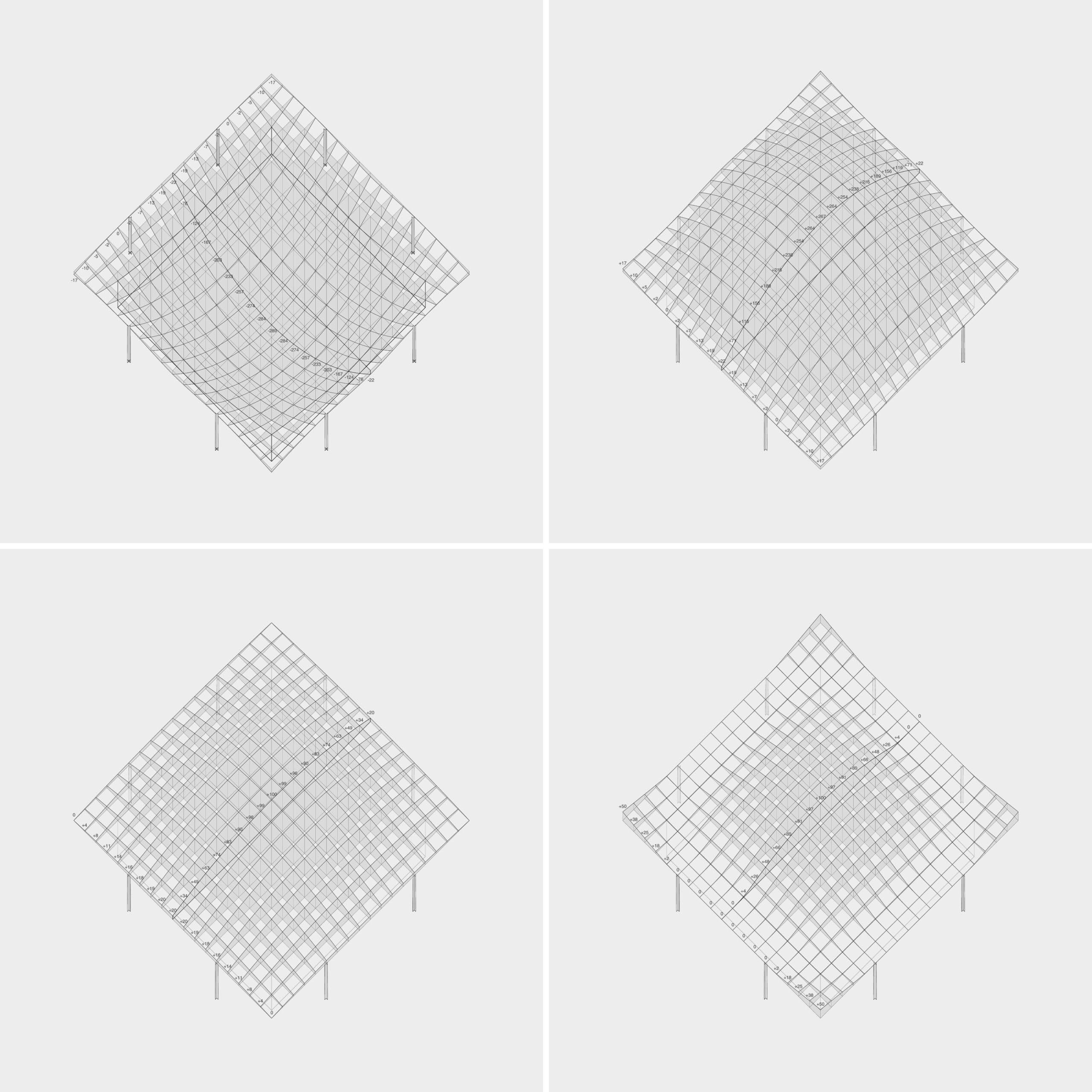
Taken collectively, the drawings presented here document many of these types of developments and more broadly look to rearticulate the rigour and steadfastness of Mies’ pursuit of an architectural language and the memetic presentation of structure. His long and stubborn quest for a universal language, born of its time and simultaneously seeking insulation from the crush of future technological advancement, was characterised by an unwavering commitment and internal focus. Mies’ influences are well known – Hendrik Berlage, Karl Friedrich Schinkel, Rudolf Schwarz. Such discussions, however, tend to omit the incredibly powerful influence of Mies on Mies and downplay the significant role his intense personal and professional introspection played in his own development. The universal space projects, especially when understood and presented as a singular project, also direct our attention away from individual masterworks, and accompanying minor ones, to a longer and more significant arc. Moreover, the aspiration of our drawing series was to outline one of Mies’ most central pursuits and to encourage a new dialogue between these projects under one umbrella.
This drawing research was undertaken by Landry Smith with Ki Yeol Baek and Harrison Moser. More projects by Landry Smith Architect can be found on their website, here.
